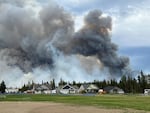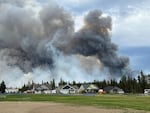Wildfires and Insurance Challenges in Oregon
Across the United States, insurance companies are pulling back from insuring properties in high-risk areas prone to natural disasters, particularly wildfires. This trend is placing significant strain on homeowners in regions like Central and Southern Oregon, where rising insurance premiums and a shrinking market are becoming increasingly problematic.
State Senator Jeff Golden, representing cities in Southern Oregon, including Talent, Ashland, and Phoenix, is deeply familiar with the issue. “I have a lot of really concerned constituents,” he stated.

In January, Oregon released updated wildfire hazard maps. These maps outline new regulations for those living in high-risk zones. Golden recently hosted a town hall meeting in Medford, where he addressed concerns from residents worried about the implications of the state’s final map. “Most of the high hazard properties are in Jackson and Josephine County, followed by Deschutes County,” he explained. “The mapping is really hard for people to understand on the ground.”
Currently, Oregon law prevents insurers from using these maps to directly adjust insurance rates. Golden is now planning to bring back a bill during the current legislative session to address the challenges related to wildfires and rising premiums. The proposed legislation would direct the Oregon State Fire Marshal to establish a program to certify neighborhoods for reducing their fire risk.
Under this program, risk assessors would inspect properties to identify measures aimed at hardening homes against fire, such as removing flammable materials and trimming trees. “If the neighbors do that … they do get a certification that we are sort of negotiating with the insurance industry to factor into their premium setting decisions,” Golden stated, while acknowledging the state’s inability to mandate lower rates.
Golden’s prior attempts to pass similar legislation faced challenges in the legislative process. “It’s had widespread policy support and then goes down to Ways and Means with 1,000 other things and doesn’t get the attention it needs,” he said.

Wildfire funding remains a top priority for Oregon lawmakers and Governor Tina Kotek. In December, the state legislature allocated $218 million to cover costs associated with the previous year’s record-breaking wildfire season during a special session called by the governor.
As the state manages wildfire-related expenses, insurance claims have significantly increased. Andrew Stolfi, the director of the Oregon Department of Consumer and Business Services and the state’s insurance commissioner, highlighted natural disasters as a major factor in this increase. “We’ve already seen nearly $3 billion in wildfire insured losses, about $1 billion in winter storm losses and a couple $100 million in wind losses,” he said. “That’s more than 4 times the last 40 years combined.”
Despite the heightened risk and escalating insurance claims, Golden pointed out the difficulties in discouraging construction in areas at high risk. “It’s a crucially difficult sociological problem,” he said. “Do we want to keep building in areas where there are flood plains or hurricane alleys or wildfire zones, that odds say are going to get destroyed again soon? It’s a really tough dilemma.”


